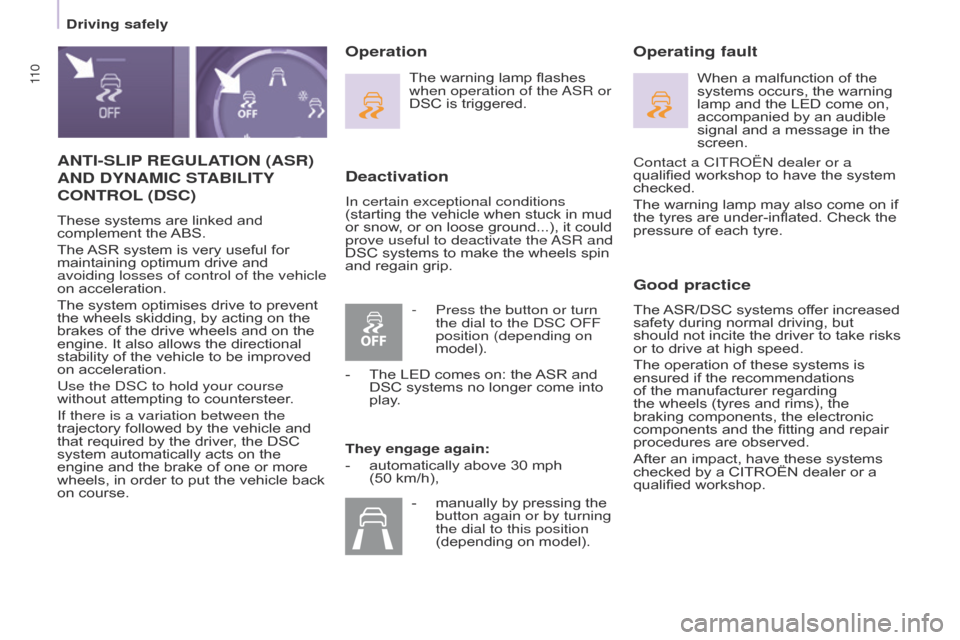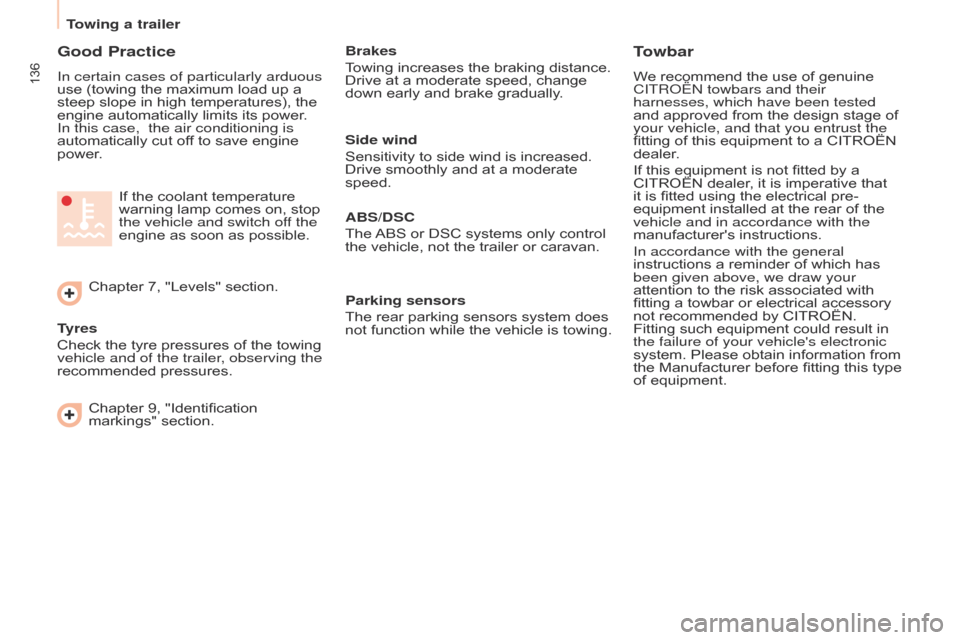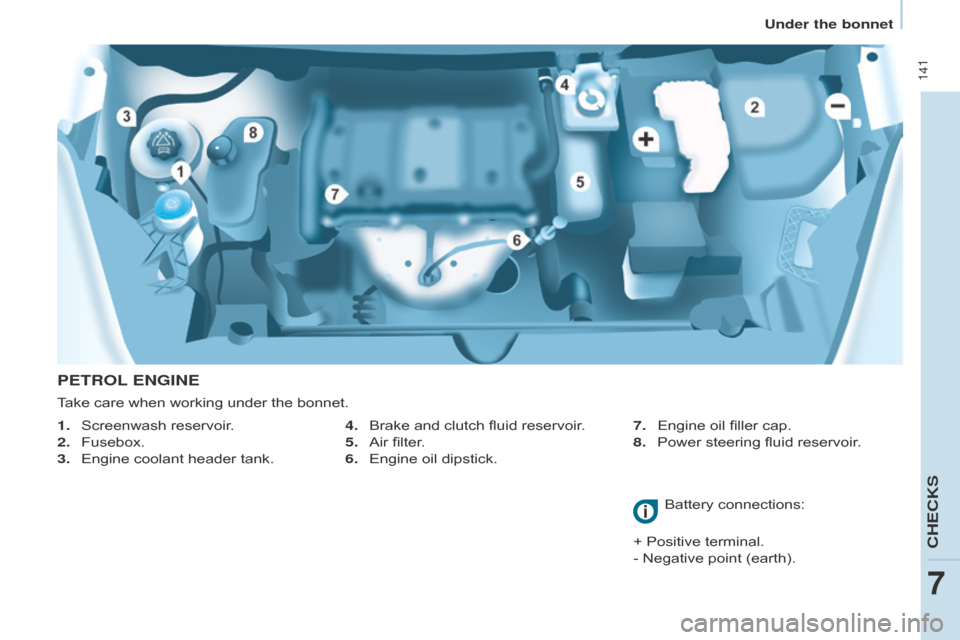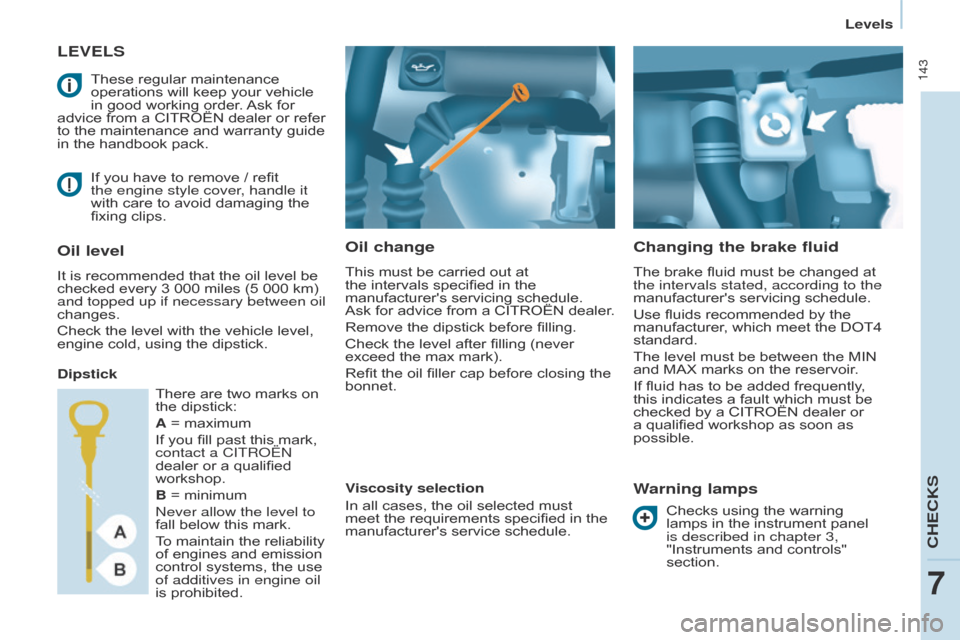check engine Citroen BERLINGO MULTISPACE RHD 2014.5 2.G User Guide
[x] Cancel search | Manufacturer: CITROEN, Model Year: 2014.5, Model line: BERLINGO MULTISPACE RHD, Model: Citroen BERLINGO MULTISPACE RHD 2014.5 2.GPages: 276, PDF Size: 12.15 MB
Page 48 of 276

Berlingo_2_VP_en_Chap03_Pret-a-partir_ed02-2014
46
Acceleration
For optimum acceleration (e.g. to overtake another vehicle), simply
press the pedal beyond the point of
resistance at the end of its travel, by
pressing
down firmly.
Vehicle stationary, with the
engine running
In the event of a prolonged stop with
the engine running, the gearbox
changes automatically to neutral n .
Stopping the vehicle
Before stopping the engine, put the
gear selector in position n .
In all cases, it is essential to apply
the
parking brake. Check that the
parking
brake warning lamp is on in the
instrument
panel.
Before doing anything in the
engine
compartment, check that
the gear selector is in neutral
n .
changing gear
In situations of high engine speeds
(heavy acceleration), a change
up will not occur unless the driver
operates the electronic gearbox control
paddle. Pull on the "+" control
paddle
to change up.
Pull on the "-" control
paddle to change
down.
-
If the vehicle stops or reduces
speed
(for example when
approaching a stop sign),
the gearbox changes down
automatically
, to first gear if
needed.
-
It is not necessary to release the
accelerator
completely during gear
changes.
-
a
gear change instruction is
accepted only if the engine speed
permits.
-
For safety reasons, depending on
the engine speed, a change down
may
be performed automatically.
Manual mode
c
hanging to manual mode
Move the gear selector to M. Automatic mode
c
hanging to automatic
mode
Move the gear selector to A.
The gearbox then operates in
automatic
mode,
without
any
action
on
your
part.
It constantly selects the gear that is
best
suited
to
the
following
conditions:
-
driving style,
-
road
profile,
-
optimum
fuel
consumption.
Gearbox and steering wheel
Page 51 of 276

Berlingo_2_VP_en_Chap03_Pret-a-partir_ed02-2014
49
reactivation
Press the "EcO OFF" switch again.
The system is active again; this is
confirmed
by the switch warning
lamp
going off and a message in the
instrument
panel.
The
system is reactivated
automatically
at every new start
using
the key.
Operating fault
In the event of a malfunction with the system, the "E c O
OFF"
switch warning lamp
flashes,
then comes on
continuously
.
Maintenance
Before working under the bonnet, deactivate the Stop & Start system
to
avoid any risk of injury resulting
from
automatic operation of START
mode.
This
system requires a specific
battery
with a special specification
and
technology (reference numbers
available
from a CITROËN dealer or a
qualified
workshop).
Fitting a battery not listed by
CITROËN introduces
the risk of
malfunction
of the system.
The
Stop & Start system makes
use
of advanced technology.
All
work
on this type of battery must
be done only by a CITR
o Ë n dealer or
a
qualified workshop.
have
it
checked
by
a
CITROËN
dealer
or
a
qualified
workshop.
In
the
event
of
a
fault
in
STOP
mode,
the
vehicle
may
stall.
All
of
the
warning
lamps
in
the
instrument
panel
come
on.
It
is
then
necessary
to
switch
off
the ignition and start the engine again
using
the
key.
Stop & Start
REadY To Go
3
Page 52 of 276

Berlingo_2_VP_en_Chap03_Pret-a-partir_ed02-2014
50
Good practice when stopping Good practice when starting
diesel pre-heating warning
lamp
If
the temperature is high
enough,
the warning lamp
comes
on for less than
one
second, you can start
without
waiting.
In cold weather, wait for this warning
lamp
to
go off then operate the starter
(Starting position) until the engine
starts.
d
oor or bonnet open
warning lamp
If this comes on, a door or the bonnet is not closed correctly, check!
Minimise engine and gearbox wear
When switching off the ignition, let the
engine run for a few seconds to allow
the turbocharger (
d iesel engine) to
return
to idle.
d
o not press the accelerator when
switching
off the ignition.
There is no need to engage a gear
after
parking the vehicle.
StArt I n G A nd S tOPPI n G
running and accessories position.
T o unlock the steering, turn the
steering wheel gently while turning the
key
, without forcing. In this position,
certain
accessories can be used.
Starting position.
The starter is operated, the engine
turns
over, release the key.
S
t
OP
position: steering lock.
The
ignition is off.
T
urn the steering
wheel
until the steering locks. Remove
the
key.
Starting and stopping
Page 53 of 276

Berlingo_2_VP_en_Chap03_Pret-a-partir_ed02-2014
51
HILL StA rt ASSIS t
This system (also called HHC - Hill Holder
Control), linked to the dynamic
stability
control system, makes hill
starts easier and is activated in the
following
conditions:
-
the
vehicle must be stationary,
engine
running, foot on the brake,
-
the
gradient of the road must be
steeper than 5%,
-
uphill,
the gearbox must be in
neutral or in a gear other than
reverse,
-
downhill,
reverse gear must be
engaged.
The Hill Start
a
ssist function is
a
driving aid system. It is not an
automatic
vehicle parking function or
an
automatic parking brake.
Operation
With the brake pedal and clutch pedal pressed, from the time you release the
brake
pedal you have approximately
2 seconds before the vehicle starts to
roll
back and without using the parking
brake
within which to move off.
During
the moving off phase, the
function
is deactivated automatically,
gradually
releasing the braking
pressure.
During this phase, the
characteristic
noise of mechanical
release
of the brakes may be heard,
indicating
the imminent movement of
the
vehicle.
Operating fault
Hill start assist is deactivated in the
following situations:
-
when the clutch pedal is released,
-
when
the parking brake is applied,
-
when the engine is switched of
f,
-
when
the engine stalls.
If
a malfunction of the
system
occurs, this
warning
lamp comes on
accompanied
by an audible
signal
and confirmed by
a
message in the screen. Have the
system
checked by at a CITROËN
dealer
or a qualified workshop.
Starting and stopping
REadY To Go
3
Page 112 of 276

11 0
Berlingo_2_VP_en_Chap05_Securite_ed02-2014
AntI-SLIP rEGuLAtIO n (AS r )
A nd d Y n AMI c S t
ABILI
t Y
c
O ntr OL ( d S c )
These systems are linked and complement the ABS.
The
ASR
system is very useful for
maintaining
optimum drive and
avoiding losses of control of the vehicle
on
acceleration.
The
system optimises drive to prevent
the
wheels skidding, by acting on the
brakes
of the drive wheels and on the
engine.
It also allows the directional
stability
of the vehicle to be improved
on
acceleration.
Use the
d SC to hold your course
without
attempting to countersteer.
If there is a variation between the
trajectory
followed by the vehicle and
that
required by the driver, the DSC
system
automatically acts on the
engine
and the brake of one or more
wheels,
in order to put the vehicle back
on
course.
deactivation
In certain exceptional conditions
(starting the vehicle when stuck in mud
or
snow, or on loose ground...), it could
prove useful to deactivate the a
SR and
DSC
systems to make the wheels spin
and
regain grip.
Operating fault
Good practice
The ASR/DSC systems offer increased safety
during normal driving, but
should
not incite the driver to take risks
or
to drive at high speed.
The
operation of these systems is
ensured
if the recommendations
of
the manufacturer regarding
the
wheels (tyres and rims), the
braking
components, the electronic
components
and the fitting and repair
procedures
are observed.
After
an impact, have these systems
checked
by a CITROËN dealer or a
qualified
workshop.
Operation
The warning lamp flashes when operation of the a SR or
DSC
is triggered.
t
hey engage again:
-
automatically
above 30 mph
(50
km/h), When
a malfunction of the systems
occurs, the warning
lamp
and the LED come on,
accompanied
by an audible
signal
and a message in the
screen.
-
Press the button or turn
the dial to the
d SC o FF
position (depending on
model).
-
The
LED comes on: the
ASR
and
DSC
systems no longer come into
play
. -
manually
by pressing the
button again or by turning
the dial to this position
(depending
on model).Contact a CITR
o Ë n dealer or a
qualified
workshop to have the system
checked.
The
warning lamp may also come on if
the
tyres are under-inflated. Check the
pressure
of each tyre.
driving safely
Page 138 of 276

136
Berlingo_2_VP_en_Chap06_Accessoire_ed02-2014
Good Practice
In certain cases of particularly arduous
use (towing the maximum load up a
steep
slope in high temperatures), the
engine
automatically limits its power.
In this case,
the air conditioning is
automatically
cut off to save engine
power
.
tyres
Check
the tyre pressures of the towing
vehicle and of the trailer
, observing the
recommended
pressures.
Chapter
7, "Levels" section.
If
the coolant temperature
warning
lamp comes on, stop
the vehicle and switch of
f the
engine
as soon as possible.Brakes
Towing
increases the braking distance. Drive
at a moderate speed, change
down
early and brake gradually.
towbar
We recommend the use of genuine CITRo Ë n towbars and their
harnesses, which have been tested
and
approved from the design stage of
your vehicle, and that you entrust the
fitting
of this equipment to a CITROËN
dealer
.
If
this equipment is not fitted by a
CITROËN
dealer, it is imperative that
it
is fitted using the electrical pre-
equipment
installed at the rear of the
vehicle and in accordance with the
manufacturer's
instructions.
In accordance with the general
instructions
a reminder of which has
been given above, we draw your
attention
to the risk associated with
fitting
a towbar or electrical accessory
not
recommended by CITROËN.
Fitting
such equipment could result in
the failure of your vehicle's electronic
system.
Please obtain information from
the
Manufacturer before fitting this type
of
equipment.
Side wind
Sensitivity
to
side
wind
is
increased.
Drive
smoothly
and
at
a
moderate
speed.
ABS/
d
S
c
The
ABS
or
DSC
systems
only
control
the
vehicle,
not
the
trailer
or
caravan.
Parking sensors
The
rear
parking
sensors
system
does
not
function
while
the
vehicle
is
towing.
Chapter
9,
"Identification
markings"
section.
towing a trailer
Page 141 of 276

Berlingo_2_VP_en_Chap07_Verification_ed02-2014
139
tOtAL & c I tr OË n
Partners in performance and
protecting the environment
Innovation in the search for
performance
For over 40 year, the T
o
T
a
L Research and
Development
departments have developed
for
CITROËN, lubricants to match the latest
technical innovations on CITR
o Ë n vehicles,
both
for competition and for everyday motoring.
For you, this is an assurance that you will
obtain
of the best performance for your engine.
Optimum protection for your
engine
By having your CITR
o Ë n
vehicle serviced with T
o
T
a
L
lubricants, you are contributing
towards
improving the life and
performances
of your engine,
while also protecting the
environment. prefers
Maintenance with tOtAL
cHEcKS
7
Page 143 of 276

Berlingo_2_VP_en_Chap07_Verification_ed02-2014
141
PEtrOL EnGInE
1. Screenwash reservoir.
2.
Fusebox.
3.
Engine
coolant header tank.
Battery
connections:
+
Positive terminal.
-
Negative point (earth).
Take
care when working under the bonnet.
4. Brake and clutch fluid reservoir.
5.
Air
filter.
6.
Engine
oil dipstick.7.
Engine oil filler cap.
8.
Power
steering fluid reservoir.
Under the bonnet
CHECkS
7
Page 145 of 276

Berlingo_2_VP_en_Chap07_Verification_ed02-2014
143
LEVELSOil change
This must be carried out at the intervals specified in the
manufacturer's
servicing schedule.
Ask
for
advice
from
a
CITROËN
dealer
.
Remove
the dipstick before filling.
Check
the level after filling (never
exceed
the max mark).
Refit
the oil filler cap before closing the
bonnet.
changing the brake fluid
The brake fluid must be changed at the intervals stated, according to the
manufacturer's servicing schedule.
Use
fluids recommended by the
manufacturer
, which meet the DOT4
standard.
The
level must be between the MIN
and
MAX marks on the reservoir.
If
fluid has to be added frequently,
this
indicates a fault which must be
checked
by a CITROËN dealer or
a
qualified workshop as soon as
possible.
Warning lamps
If you have to remove / refit
the engine style cover , handle it
with
care to avoid damaging the
fixing
clips.
Oil level
It is recommended that the oil level be checked every 3 000 miles (5 000 km)
and topped up if necessary between oil
changes.
Check
the level with the vehicle level,
engine
cold, using the dipstick.
d
ipstick
Viscosity selection
In
all cases, the oil selected must
meet
the requirements specified in the
manufacturer's
service schedule.
These
regular maintenance
operations
will keep your vehicle
in
good working order.
Ask
for
advice
from a CITROËN dealer or refer
to
the maintenance and warranty guide
in
the handbook pack.
Checks using the warning
lamps
in the instrument panel
is described in chapter 3,
"Instruments
and controls"
section.
There
are two marks on
the
dipstick:
A
= maximum
If
you fill past this mark,
contact a CITR
o Ë n
dealer
or a qualified
workshop.
B
= minimum
n
ever allow the level to
fall
below this mark.
To
maintain the reliability
of
engines and emission
control
systems, the use
of additives in engine oil
is
prohibited.
Levels
CHECkS
7
Page 146 of 276

Berlingo_2_VP_en_Chap07_Verification_ed02-2014
144
cooling system
Only use the fluid recommended by the manufacturer.
Otherwise,
you risk seriously damaging
your
engine.
When
the engine is warm, the
temperature
of the coolant is controlled
by
the engine fan.
As
this fan can
operate
with the ignition key removed
and
because the cooling system is
pressurised, wait for at least one hour
after the engine has stopped before
carrying
out any work.
Slacken
the cap by 1/4 of a turn to
release the pressure to prevent any
risk
of scalding. When the pressure
has
dropped, remove the cap and top
up
the level with coolant.
If
fluid has to be added frequently,
this
indicates a fault which must be
checked
by a CITROËN dealer as
soon
as possible.
Power steering fluid level
The vehicle must be parked on level ground with the engine cold. Unscrew
the cap integrated with the gauge and
check
the level which must be between
the
MIN and MAX marks. In
order to regenerate the filter, you are advised to drive at a speed higher
than
40 mph (60 km/h) for at least five minutes
as soon as possible, when
traffic
conditions permit (until the
message
disappears and the service
warning
lamp goes off).
d
uring regeneration of the particle
emission
filter, the noise of a relay
operating
may be heard under the
dashboard.
If
the message is still displayed and
if
the service warning lamp remains
on, contact a CITR
o Ë n dealer or a
qualified
workshop.
topping up
The
level
must
be
between
the
MIN
and
MAX
marks
on
the
expansion
bottle.
If
more
than
1
litre
of
fluid
is
required
to
top
up
the
level,
have
the
system
checked
by
a
CITROËN
dealer
or
a
qualified
workshop.
Screenwash and headlamp
wash level
For best quality cleaning and for your safety , we would advise that you use
products
of the CITROËN range.
For
optimum cleaning and to avoid
freezing,
this fluid must not be topped
up
or replaced with plain water.
Capacity
of the screenwash reservoir:
approximately
3 litres.
If
your vehicle is fitted with headlamp
washers, the capacity of the reservoir
is
6 litres.
diesel additive level
( d iesel with particle
emission filter)
topping up
This additive must be topped up by
a
CITROËN dealer or a qualified
workshop
without delay.
Waste products
avoid prolonged contact of used oil
with the skin.
Brake
fluid is harmful to health and
very
corrosive.
Do
not dispose of used oil, brake fluid
or coolant into drains or into the ground
but into the containers dedicated to this
use at a CITR
o Ë n dealer (France) or
an
authorised waste disposal site.
The
minimum
level
of
this
additive
is indicated by lighting of the service
warning
lamp,
accompanied
by
an
audible
signal
and
a
message
in
the
screen.
When this occurs with the engine
running it is due to the start of
saturation
of
the
particle
emission
filter
(exceptionally prolonged urban type
driving
conditions:
low
speed,
long
traffic
jams,
...).
Levels